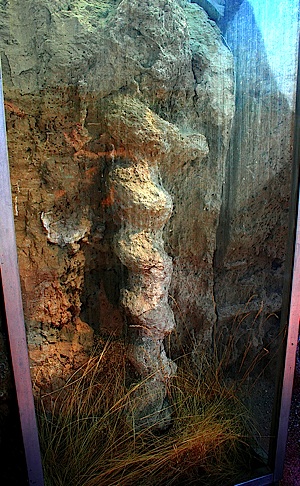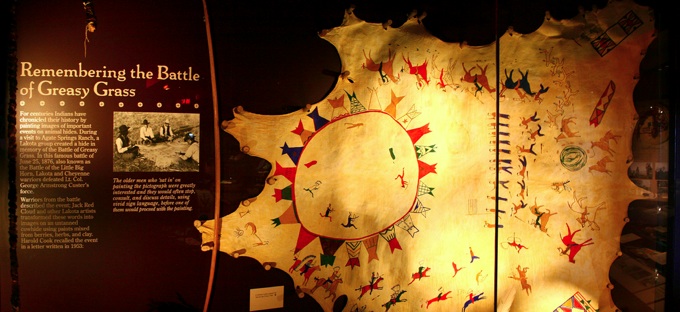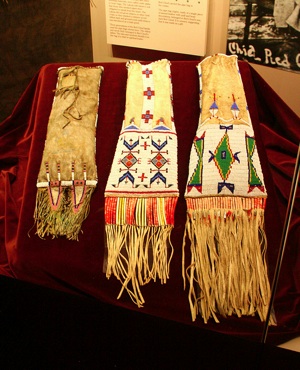In the ranching country of western Nebraska lies a small national park unit with a big name, Agate Fossil Beds National Monument. It emphasizes two treasures, but it also holds some unexpected riches on this prairie landscape.
“Agate” is named after James Cook’s Agate Springs Ranch, a privately-owned working ranch that still lies just outside the park. Cook was an adventurer of the Old West who eventually settled down in this country when it was still Indian land. A man of diverse interests, his stamp is evident throughout the park.
A Fossilized Landscape
As the name suggests the main focus of Agate Fossil Beds lies in a rich collection of fossils. The main sites, long since excavated, lie on University Hill and Carnegie Hill, named after the University of Nebraska and the Carnegie Museum. New York’s American Museum of Natural History also excavated here. Though local Native Americans knew of these bones, apparently Euro-American science did not discover the fossils here until about 1904.
The fossil beds are not the only paleontological attractions, however. In fact, I’d start your journey with the Daemonelix (Devil’s Corkscrew) formations just inside the park’s west entrance. The Daemonelix are exposed, corkscrew-shaped formations a little bigger than the size of your arm. James Cook found them on his ranch, and brought them to the attention of scientists at some point in the early 1890s.
After some years of debate, scientists figured out that these corkscrews are the fossilized burrows of Paleocastor, a forerunner of modern beavers that lived in colonies like modern prairie dogs. Erosion on the side of several bluffs has exposed the burrows here. You can find them on an attractive loop trail just inside the western park entrance.

A fossilized burrow. Bob Pahre photo.
One hillside has a group of exposed Daemonelices from a Paleocastor colony—see if you can find at least five of them.
A little further on, the National Park Service preserves two particularly noteworthy examples under plexiglass. Keep an eye out for the other attractions along the trail, including “petrified” sand dunes and some geology exhibits.
A scenic overlook at the mid-point of the trail will orient you to the landscape here and give you a beautiful view of the Niobrara River and its floodplain.
After the Daemonelix trail, continue on to the visitor center. This interprets the two main attractions of the park, the fossil discoveries and the James Cook Collection. Many of the animals died here after getting stuck in the mud at a water hole in the Miocene Epoch (21-19 million years ago).
The visitor center reconstructs the water hole scene with a mix of original fossils, slabs, and casts of the original bones. Other displays explain how scientists found clues in the fossils and rocks to reconstruct the scene on display here. To learn more about the paleontological history of the site, take the loop trail up to Carnegie and University Hills. None of the bones are visible today, so you’ll have to imagine the site with the help of photographs on the interpretive signs.
Once you climb the hills, the trail follows the level of the main excavation, where the water hole once was. You can return to the visitor center or take a faint trail to the “Bone Cabin” that served as the base for the paleontologists. The Park Service is reconstructing the Bone Cabin after years of disrepair, and it’s not open to the public yet. James Cook’s son Harold originally built this cabin to establish a homestead claim to all the fossil beds here. Watching the excavations fascinated him so much that he became a paleontologist himself.
After working at the family ranch and studying back East, Harold eventually became a paleontologist in Colorado. Harold also helped his father navigate the professional rivalries among the various teams of bone collectors at Agate. The competitions could get a bit fierce as each team wanted to gather as many fossils as possible to display in their own museum. The Park Service does not make much of these prestigious institutions’ unseemly scrambles for bones here, but it does tell us how these finds contributed to science and to our understanding of the Miocene.

Though the monument's name might leave the impression only fossils are found here, there is a rich history of Lakota Sioux as well. Bob Pahre photo.
Rich Lakota History And Artworks
In addition to the fossil exhibits, the visitor center also houses the James H. Cook Collection of Oglalla Lakota (Sioux) art. Rancher James Cook met Lakota Chief Red Cloud in the mid-1870s and they became lifelong friends.
Red Cloud and his band usually visited Cook each summer, camping outside his ranch house. After being removed to the Pine Ridge Reservation, Red Cloud continued to visit. These journeys gave Red Cloud and his people an opportunity to travel the plains as they once had, enjoying the company of friends and one another.
The Lakota brought Cook hospitality gifts each summer. Some were special pieces of art, such as decorative shields and painted buffalo hides. For example, one shield here has a bison painted on it, and there is a collection of feathers from various birds, species chosen for their significance to their owner. It is an object of considerable beauty and spiritual power.
Other gifts were finely-made everyday items such as moccasins, brushes and other grooming items. The Lakota made some gifts especially for Cook, such as buckskin suits and gloves. Other gifts were family heirlooms, including one of Crazy Horse’s whetstones and three pipe bags that had belonged to Red Cloud, his father, and his son.
The visitor center also has some remarkable “winter counts” painted by modern artists. A winter count was a story of the year painted on a buffalo hide, a form of Lakota history-keeping. One of the winter counts on display is a modern reproduction of a historic winter count made at the Agate Springs Ranch.
To some degree, this collection of arts and crafts is here because most of the fossils are not. James Cook was disappointed that most of the fossils from his ranch were taken to the University of Nebraska and to museums back east. He didn’t want that to happen to his art collection, and insisted that it remain here. That bit of history hints at a larger problem.

Lakota pipe bags that belonged to Red Cloud, his father, and his son. Bob Pahre photo.
Looking To the Future
Congress made Agate a national monument to recognize its remarkable fossil beds, but most of the fossils are gone. Agate used to show fossils in situ, but safety concerns and the risk of theft shut that down.
Today Agate is more like a national historic site or battlefield, remembering actions that happened here once upon a time, but are long gone today. That makes the remaining fossils and the Cook Collection all the more special. Continuing to developing Bone Cabin will also help make the site more alive, and we can hope that funding will be available for that. The Park Service could also develop the site’s other resources, especially the Red Cloud story and the Niobrara River.
Well downstream from Agate, about 50 miles of the Niobrara River are part of the national scenic river system. However, there is also a beautiful wild stretch of the river in Agate.
Though the park is only four miles long, 11 river miles wind back and forth, creating an extensive wetland on the valley bottom. The Park Service and other agencies are already studying this stretch here for possible recognition as a national wild and scenic river. Though it’s really just a stream here, it’s lovely and it’s natural.
Another option for Agate would be to add more recreational options. There’s room for an all-day hiking trail of five or ten miles, exploring the wetlands, the bluffs, and the plains. Agate provides a beautiful example of a Great Plains landscape without too much human impact visible, and a longer trail would help people appreciate it more fully.
Though it’s already doing a good job telling visitors about Red Cloud, Agate could present a longer view of Native American history across a wider region. Most of the national parks of the Great Plains that tell American Indian stories emphasize contact with Euro-Americans at forts, trading posts, and battlefields. Agate could do something different. It could tell the story of the pre-contact Natives, and then bring the story forward to Red Cloud and the transition to reservation life.
Since it’s already telling the last part of the story, starting at the beginning would be a natural step. The park’s historic resources study already has lots of information about the American Indians of the region. The Oglalla Lakota Nation at nearby Pine Ridge could be a more visible partner here, as it is at the South Unit of Badlands National Park in South Dakota.
The park has some evidence of prehistoric campsites here, and those might provide the material foundations for greater interpretation of prehistory here. Prehistoric campsites are thoroughly ordinary, and all too often we overlook ordinary lives in order to focus on the extraordinary.
Ideas such as those have already been tossed around as part of Agate’s planning process. Following through on some of them would help make Agate an even more attractive site and encourage more people to take a look. As it is, it only gets about 12,000 visitors a year. That’s a pity for such a lovely site rich in both natural history and human history.
Though Agate lies a bit off the beaten track, it’s easy to make it part of a larger itinerary. If you’re following the Oregon Trail past Chimney Rock, Scotts Bluff, and Fort Laramie, it’s less than an hour north of Scottsbluff and well worth the detour. If you want to connect Scotts Bluff to the Black Hills, you could approximate Red Cloud’s trail from the Pine Ridge Indian Reservation and then head to Badlands South Unit or veer west to Wind Cave. You could also drop down from the Black Hills for the day if you’re not interested in the Oregon Trail sites.
If you’re in the neighborhood, be sure to drop by. The Daemonelices are waiting.
Bob Pahre is a professor of political science at the University of Illinois, Urbana-Champaign. His research and teaching focuses focuses on environmental politics, U.S. national parks, and the European Union. He's authored academic publications on Yellowstone National Park, Isle Royale National Park, and Fort Davis National Historic Site, and some other articles on Big Bend, Dinosaur, and the national parks of the Midwest.


 Support Essential Coverage of Essential Places
Support Essential Coverage of Essential Places







Comments
Thanks for the nice story. When visiting the park in July 2011 we were there in the late afternoon, as visitors no. 62/63 of that day. So chances are high that you'll have one of the trails or even the whole park for yourself alone when visiting. Which is even better to fully take in the unspoiled prairie landscapes. A real gem of a park, highly recommended.
Agate is one of the great little surprises in the park system: interesting fossils, unspoiled prairies, and there's never been a crowd when I've visited. Unfortunately, owe Agate a return visit: thanks to a pesky rattlesnake who just wouldn't let me pass, I never got to the quarries on the Quarry Trail. All I got was a great picture of an angry rattler!
I have visited AFBNM a couple of times, and I agree that it is a charming spot, especially the nature trail and the Niobrara River. The Cook collection is outstanding and that is fortunate, because, let's face it, the principal resource has left the building. AFB is a depleted National Monument. Future excavation might expose new material, but how could it be protected and displayed?
An interesting contrast, in several respects, is The Mammoth Site in Hot Springs, South Dakota. The nature of the deposit allows its protection, study, display, and interpretation within a secure building by a non-profit corporation. One can see,up close, the in situ bones of at least 60 mammoths trapped in a sinkhole about 25,000 years ago.
Full disclosure - For the past twelve years, after retiring from my NPS career, I have been a paid TMS employeem during their July excavations, supervising Earthwatch volunteers. I am favorably impressed by the management of these very significant deposits by a private organization. Factors that allow this at TMS are not present at AFB.
Thank you, everyone, for the nice comments and for sharing your own memories.
An interesting set of challenges you raise, Don. One of my writing interests is comparing public and private management of comparable resources.
That's a beautiful looking trail in that first photo. It would be nice if this area tied in with the Great Plains Trail.
Visited here about August of 2011, and remember the staff were thrilled to have visitors. Great little facility, interesting collection, really enjoyed our visit. The daemonelices are fascinating. The Oglalla Lakota art collection is simply stunning. We also visited The Mammoth Site on the same trip, and recommend both as well worthy of a visitor's time.